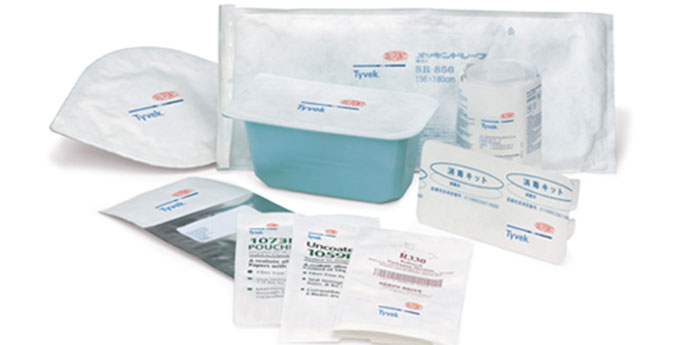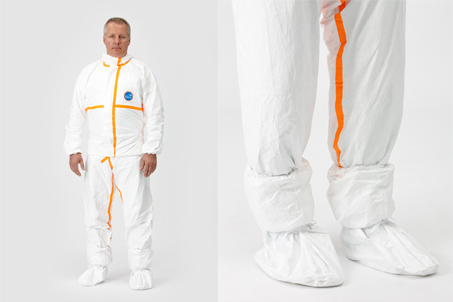Tyvek is a widely used packaging material branded and trademarked by DuPont Company. DuPont was originally founded in 1802, as a gunpowder mill. Since then, the company has dedicated themselves to science and engineering to develop different products such as nylon, neoprene, Mylar, Kapton, Corian, etc. Tyvek is among these different products and was constructed for its flash spun high-density polyethylene fibers.

Tyvek is a sought-after material that was first discovered in 1955 by one of DuPont's researchers, Jim White. White saw polyethylene fluff coming out of a pipe that was used in another experiment that led him to creating Tyvek. DuPont then patented the material and started selling it in 1967, commercially. Tyvek is a huge innovator because its fibers are so small and fine which makes it extremely useful for industry. The fibers are about 0.5-10µm which can be compared to 75µm of human hair. Having small fibers creates an advantage for the material because it is very strong and difficult to tear but can be easily cut. Being easy to cut can be a huge benefit when used in real-world application. Tyvek has the same coloring and texture as paper and can also be written on, but it is made from a synthetic plastic. Some of its properties include chemical resistance, water resistance, dimensional stability, light weight and thin, and can be flammable. DuPont has many sustainability accomplishments for Tyvek that include: "one of the first companies to publicly establish environmental goals over 20 years ago; reduced its global greenhouse emissions by 72% in 2003; successfully met its goal of holding total energy flat; introduced 928 new products or services that help make people safer; and invested $667 million in R&D programs with direct, quantifiable environmental benefits for customers and consumers" (https://www.dupont.com). With these sustainability accomplishments, Tyvek can be and is recyclable. Tyvek is also so light-weight and thin that it allows water vapor to easily pass through but not liquid water. Having the ability of water vapor passing through easily is an advantage when it comes to sterilization of Tyvek packaging. Tyvek should only use vinyl acetate, water-based synthetic lattices, acrylic pressure-sensitive tape, and hot glue as highly effective adhesives. According to Mark Orwell, a writer for Sciencing, Tyvek is used for packaging instruments and bandages in the medical field. UPS uses it to make envelopes as well as sleeves for CD's and DVD's. Tyvek can be used for ground covers for campers and even house wraps during construction of a house. It can also be used for clothing such as windbreakers, overalls for industry workers, and lab coats for working with hazardous materials (https://www.sciencing.com). Tyvek is ideal for these different products because it can protect them in ways another material can't.

Specific to the medical device industry, Tyvek is a huge aid in the industry's packaging. According to Cleanroom Technology, medical device packaging should be: "made of known and traceable materials; non-toxic; non-leaching; odorless; free of holes and tears; intended for use in medical applications; allow sterilization; provide physical protection; and to maintain sterility up to the point of use" (https://www.cleanroomtechnology.com). Medical device packaging must go through many rigorous regulation and compliance to protect the safety and health of a patient. When picking the right material for packaging medical devices, it must be able to follow these rules and be efficient when manufactured. Tyvek easily covers the guidelines and can be used to do several different things in a cost-effective way. Cross-linked polyethylene foams, thermoplastic polyurethane (TPU) films, and rigid plastics are the three main materials that are needed in the medical device packaging industry. Tyvek material falls under all three categories. Tyvek is mostly used for films, sterilization pouches, syringe packaging, header bags, and steam sterilized bags. According to DuPont, some key advantages for Tyvek material is: "excellent performance as lids for rigid trays; excellent performance with common flexible films in form-fill-seal manufacturing and pouch and bag applications; compatibility with the broadest range of sterilization processes; best material for your global distribution challenges; provides outstanding toughness and tear resistance; tested and proven in a range of medical applications; superior performance to alternatives such as medical-grade paper; cost efficient grades and production optimization choices" (https://www.dupont.com). DuPont says that Tyvek is a trusted material and backed with quality.

There are also some limitations when it comes to Tyvek and medical device packaging. Tyvek has some certain sealing methods with adhesive like: water-based synthetic lattices, ethylene/vinyl acetate, acrylic pressure sensitive tape, solvent-based single component polyurethane, and hot glue. If this process isn't done exactly right, it could affect the sterilization process for the medical product. For instance, heat sealing can melt Tyvek resulting in bonding with itself which then creates puckers in the flat material. Puckers can trap tiny air pockets that are larger than the porous holes which allows contamination to happen. A company that has other methods of sterilization is another limitation to Tyvek. Other materials like, plastic, can be sterilized with an electron-beam and irradiation unlike Tyvek. When compared to other materials, Tyvek can't contribute the same uses. A material such as aluminum, is used as a barrier layer in lamination which can protect against light, oxygen, and moisture. Although it has some limitations, Tyvek is still a very popular material.


































